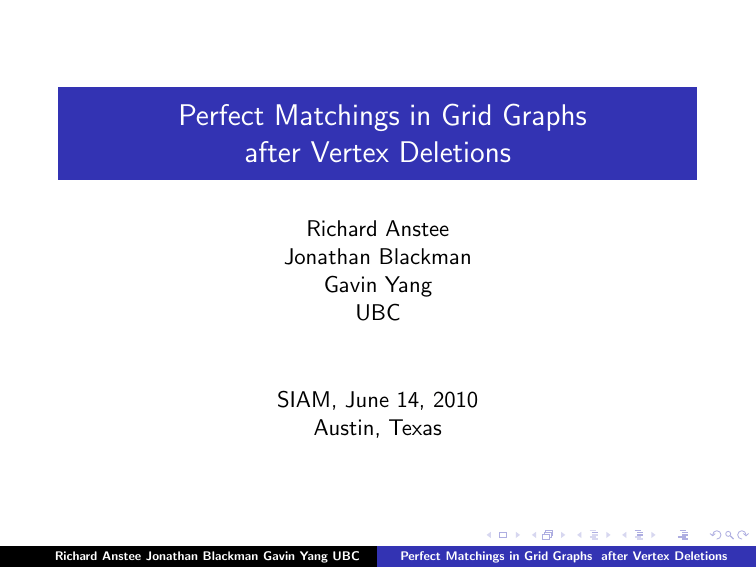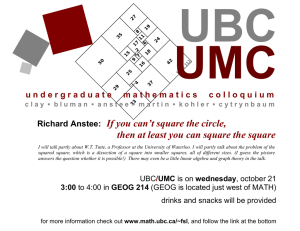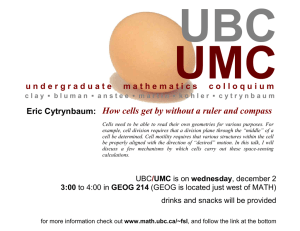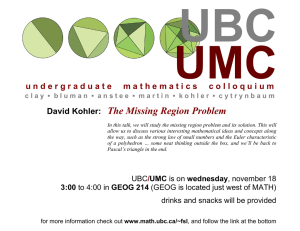Perfect Matchings in Grid Graphs after Vertex Deletions Richard Anstee Jonathan Blackman
advertisement

Perfect Matchings in Grid Graphs
after Vertex Deletions
Richard Anstee
Jonathan Blackman
Gavin Yang
UBC
SIAM, June 14, 2010
Austin, Texas
Richard Anstee Jonathan Blackman Gavin Yang UBC
Perfect Matchings in Grid Graphs after Vertex Deletions
Introduction
A perfect matching in a graph is a set of edges such that each
vertex in the graph is incident with one edge of the matching.
Richard Anstee Jonathan Blackman Gavin Yang UBC
Perfect Matchings in Grid Graphs after Vertex Deletions
The 8 × 8 grid.
This graph has many perfect matchings.
Richard Anstee Jonathan Blackman Gavin Yang UBC
Perfect Matchings in Grid Graphs after Vertex Deletions
The 8 × 8 grid with two deleted vertices.
.
Richard Anstee Jonathan Blackman Gavin Yang UBC
Perfect Matchings in Grid Graphs after Vertex Deletions
The black/white colouring revealed:
No perfect matching in the remaining graph.
Richard Anstee Jonathan Blackman Gavin Yang UBC
Perfect Matchings in Grid Graphs after Vertex Deletions
A convex portion of the triangular grid
Richard Anstee Jonathan Blackman Gavin Yang UBC
Perfect Matchings in Grid Graphs after Vertex Deletions
A convex portion of the triangular grid
A near perfect matching in a graph is a set of edges such that all
but one vertex in the graph is incident with one edge of the
matching. Our convex portion of the triangular grid has 61 vertices
and many near perfect matchings.
Richard Anstee Jonathan Blackman Gavin Yang UBC
Perfect Matchings in Grid Graphs after Vertex Deletions
Theorem (A., Tseng 06) Let T = (V , E ) be a convex portion of
the triangular grid and let X ⊆ V be a set of vertices at mutual
distance at least 3. Then T \X has either a perfect matching (if
|V | − |X | is even) or a near perfect matching (if |V | − |X | is odd).
Richard Anstee Jonathan Blackman Gavin Yang UBC
Perfect Matchings in Grid Graphs after Vertex Deletions
Theorem (A., Tseng 06) Let T = (V , E ) be a convex portion of
the triangular grid and let X ⊆ V be a set of vertices at mutual
distance at least 3. Then T \X has either a perfect matching (if
|V | − |X | is even) or a near perfect matching (if |V | − |X | is odd).
We have deleted 21 vertices from the 61 vertex graph, many at
distance 2.
fill
Richard Anstee Jonathan Blackman Gavin Yang UBC
Perfect Matchings in Grid Graphs after Vertex Deletions
Theorem (A., Tseng 06) Let T = (V , E ) be a convex portion of
the triangular grid and let X ⊆ V be a set of vertices at mutual
distance at least 3. Then T \X has either a perfect matching (if
|V | − |X | is even) or a near perfect matching (if |V | − |X | is odd).
We have chosen 19 red vertices S from the remaining 40 vertices
and discover that the other 21 vertices are now all isolated and so
the 40 vertex graph has no perfect matching.
Richard Anstee Jonathan Blackman Gavin Yang UBC
Perfect Matchings in Grid Graphs after Vertex Deletions
Definition We define a d-dimensional grid graph G md as follows:
Let [m] = {1, 2, . . . , m}. Define
V (Gmd ) = {(x1 , x2 , . . . , xd ) : xi ∈ [m] for i ∈ [d]}
and then we join (x1 , x2 , . . . xm ) and (y1 , y2 , . . . , ym ) by an edge if
d
X
|xi − yi | = 1.
i =1
Richard Anstee Jonathan Blackman Gavin Yang UBC
Perfect Matchings in Grid Graphs after Vertex Deletions
Main Theorem
Theorem (Aldred, A., Locke 07 (d = 2),
A., Blackman, Yang 10 (d ≥ 3)).
Let m, d be given with m even and d ≥ 2. Then there exist
constants ad and bd (depending only on d) for which we set
k = dad m1/d + bd e
k is Θ(m1/d ) .
Let Gmd have bipartition V (Gmd ) = B ∪ W .
Then for B 0 ⊂ B and W 0 ⊂ W satisfying
i) |B 0 | = |W 0 |,
ii) For all x, y ∈ B 0 , d(x, y ) > 2k,
iii) For all x, y ∈ W 0 , d(x, y ) > 2k,
we may conclude that Gmd \(B 0 ∪ W 0 ) has a perfect matching.
Richard Anstee Jonathan Blackman Gavin Yang UBC
Perfect Matchings in Grid Graphs after Vertex Deletions
Hall’s Theorem
A bipartite graph has a perfect matching if for each choice of a
subset A of one part, |A| ≤ |N(A)|.
Richard Anstee Jonathan Blackman Gavin Yang UBC
Perfect Matchings in Grid Graphs after Vertex Deletions
Hall’s Theorem
A bipartite graph has a perfect matching if for each choice of a
subset A of one part, |A| ≤ |N(A)|. Now consider the grid Gm3 :
Richard Anstee Jonathan Blackman Gavin Yang UBC
Perfect Matchings in Grid Graphs after Vertex Deletions
Hall’s Theorem
A bipartite graph has a perfect matching if for each choice of a
subset A of one part, |A| ≤ |N(A)|. Now consider the grid Gm3 :
If we let A be the white vertices in the green cube, then
|N(A)| − |A| is about 6 × 21 ( 12 m)2 .
Richard Anstee Jonathan Blackman Gavin Yang UBC
Perfect Matchings in Grid Graphs after Vertex Deletions
Hall’s Theorem
A bipartite graph has a perfect matching if for each choice of a
subset A of one part, |A| ≤ |N(A)|. Now consider the grid Gm3 :
If we let A be the white vertices in the green cube, then
|N(A)| − |A| is about 6 × 21 ( 12 m)2 .
If the deleted blacks are about cm 1/3 apart then we can fit about
1
m2/3 )3 inside the small green cube.
( 2c
Richard Anstee Jonathan Blackman Gavin Yang UBC
Perfect Matchings in Grid Graphs after Vertex Deletions
Hall’s Theorem
A bipartite graph has a perfect matching if for each choice of a
subset A of one part, |A| ≤ |N(A)|. Now consider the grid Gm3 :
If we let A be the white vertices in the green cube, then
|N(A)| − |A| is about 6 × 21 ( 12 m)2 .
If the deleted blacks are about cm 1/3 apart then we can fit about
1
m2/3 )3 inside the small green cube.
( 2c
We may choose c small enough so that we cannot find a perfect
matching.
Richard Anstee Jonathan Blackman Gavin Yang UBC
Perfect Matchings in Grid Graphs after Vertex Deletions
Hall’s Theorem
Given a bipartite graph, then the graph has a perfect matching if
for each choice of A a subset of one part
|A| ≤ |N(A)|.
Given we have deleted white and black vertices W 0 , B 0 , we must
have for each choice of A ⊂ W \W 0 ,
|A| ≤ |N(A)| − |B 0 ∩ N(A)|
Richard Anstee Jonathan Blackman Gavin Yang UBC
Perfect Matchings in Grid Graphs after Vertex Deletions
Hall’s Theorem
Given a bipartite graph, then the graph has a perfect matching if
for each choice of A a subset of one part
|A| ≤ |N(A)|.
Given we have deleted white and black vertices W 0 , B 0 , we must
have for each choice of A ⊂ W \W 0 ,
|A| ≤ |N(A)| − |B 0 ∩ N(A)|
We may assume |A ∪ N(A)| ≤ 12 md .
We may also consider components R = X ∪ N(X ) in G md
(with X ⊆ A).
Richard Anstee Jonathan Blackman Gavin Yang UBC
Perfect Matchings in Grid Graphs after Vertex Deletions
Main Inequalities
We assume R = X ∪ N(X ) is a connected component of G md for
some X ⊆ W \W 0 and |R| ≤ 21 md . There are constants c, c 0 , c 00
depending only on d so that
|N k (R)| ≤ |R| + ck d−1 |∂R|
(2d /d!)k d ≤ |N k (x)| ≤ 2d k d
|N(X )| − |X | ≥ c 0 |∂R|
|N(X )| − |X | ≥ c 00
Richard Anstee Jonathan Blackman Gavin Yang UBC
|R|
m
Perfect Matchings in Grid Graphs after Vertex Deletions
How many deleted blacks in a region?
If x, y ∈ B 0 , then because d(x, y ) > 2k we deduce that
N k (x) ∩ N k (y ) = ∅.
We obtain the estimate
(R = X ∪ N(X ))
|B 0 ∩ N(X )| ≤
Richard Anstee Jonathan Blackman Gavin Yang UBC
|N k (R)|
|N k (x)|
Perfect Matchings in Grid Graphs after Vertex Deletions
Let f (k, d) denote |N k (x)| in d dimensions.
Richard Anstee Jonathan Blackman Gavin Yang UBC
Perfect Matchings in Grid Graphs after Vertex Deletions
Let f (k, d) denote |N k (x)| in d dimensions.
Richard Anstee Jonathan Blackman Gavin Yang UBC
Perfect Matchings in Grid Graphs after Vertex Deletions
Let f (k, d) denote |N k (x)| in d dimensions.
We discover f (k, d) = f (d, k). Also f (1, 1) = 3, f (2, 2) = 13 and
f (3, 3) = 63. From these three terms we may access Sloane’s
Catalog of Integer Sequences and discover that f (k, d) is a
Delannoy number. We only need an estimate:
(2d /d!)k d ≤ |N k (x)| ≤ 2d k d .
Richard Anstee Jonathan Blackman Gavin Yang UBC
Perfect Matchings in Grid Graphs after Vertex Deletions
N k (R) = R ∪ ∪x∈∂R N k (x)
Assume we have a closed walk x1 , x2 , x3 . . . xn with ∪ni=1 xi = ∂R.
Then we can compute
∪x∈∂R N k (x) = ∪ni=2 N k (xi +1 )\N k (xi ) ≤ ck d−1 |∂R|
Richard Anstee Jonathan Blackman Gavin Yang UBC
Perfect Matchings in Grid Graphs after Vertex Deletions
N k (R) = R ∪ ∪x∈∂R N k (x)
Assume we have a closed walk x1 , x2 , x3 . . . xn with ∪ni=1 xi = ∂R.
Then we can compute
∪x∈∂R N k (x) = ∪ni=2 N k (xi +1 )\N k (xi ) ≤ ck d−1 |∂R|
Richard Anstee Jonathan Blackman Gavin Yang UBC
Perfect Matchings in Grid Graphs after Vertex Deletions
N k (R) = R ∪ ∪x∈∂R N k (x)
Assume we have a closed walk x1 , x2 , x3 . . . xn with ∪ni=1 xi = ∂R.
Then we can compute
∪x∈∂R N k (x) = ∪ni=2 N k (xi +1 )\N k (xi ) ≤ ck d−1 |∂R|
Richard Anstee Jonathan Blackman Gavin Yang UBC
Perfect Matchings in Grid Graphs after Vertex Deletions
N k (R) = R ∪ ∪x∈∂R N k (x)
Assume we have a closed walk x1 , x2 , x3 . . . xn with ∪ni=1 xi = ∂R.
Then we can compute
∪x∈∂R N k (x) = ∪ni=2 N k (xi +1 )\N k (xi ) ≤ ck d−1 |∂R|
Richard Anstee Jonathan Blackman Gavin Yang UBC
Perfect Matchings in Grid Graphs after Vertex Deletions
N k (R) = R ∪ ∪x∈∂R N k (x)
Assume we have a closed walk x1 , x2 , x3 . . . xn with ∪ni=1 xi = ∂R.
Then we can compute
∪x∈∂R N k (x) = ∪ni=2 N k (xi +1 )\N k (xi ) ≤ ck d−1 |∂R|
Richard Anstee Jonathan Blackman Gavin Yang UBC
Perfect Matchings in Grid Graphs after Vertex Deletions
We would like to show ∂R is connected but that is problematical
on two grounds.
Richard Anstee Jonathan Blackman Gavin Yang UBC
Perfect Matchings in Grid Graphs after Vertex Deletions
We would like to show ∂R is connected but that is problematical
on two grounds.
d \R is connected but in general
1. We would need that R c = V∞
d \R is a union of components C , C , . . .. Thinking of C as the
V∞
0
1
0
infinite component, we think of the remaining components
d \C is connected.
C1 , C2 , . . . as holes of R. We do have that V∞
i
Richard Anstee Jonathan Blackman Gavin Yang UBC
Perfect Matchings in Grid Graphs after Vertex Deletions
We would like to show ∂R is connected but that is problematical
on two grounds.
d \R is connected but in general
1. We would need that R c = V∞
d \R is a union of components C , C , . . .. Thinking of C as the
V∞
0
1
0
infinite component, we think of the remaining components
d \C is connected.
C1 , C2 , . . . as holes of R. We do have that V∞
i
d \C ) = ∂ + C is connected
2. We would like to deduce that ∂(V∞
i
i
d
for each i but this is not true in G∞ . This is easy enough to
overcome namely we can deduce that ∂ + Ci is αd -connected. We
d to include all diagonals (of each unit
need to extend G∞
hypercube) and αd -connectivity is defined in terms of this
extended edge set.
(Deuschel, Pisztora 96, Hermann 98)
Richard Anstee Jonathan Blackman Gavin Yang UBC
Perfect Matchings in Grid Graphs after Vertex Deletions
Recall k = dad m1/d + bd e
i.e. k is Θ(m 1/d ).
We must establish the following inequality:
k (R)|
(R = X ∪ N(X ))
|N(X )| − |X | ≥ |N
|N k (x)|
d
or establish | 2d! k d ||(|N(X )| − |X |) ≥ |R| + ck d−1 |∂R|
using our inequalities |N k (R)| ≤ |R| + ck d−1 |∂R| and
d
|N k (x)| ≥ 2d! k d
d
or establish | 2d! k d − cc0 k d−1 ||(|N(X )| − |X |) ≥ |R|
using our inequality |N(X )| − |X | ≥ c 0 |∂R|
d
or establish ( 2d! k d − cc0 k d−1 )(c 00 m1 |R|) ≥ |R|
using our inequality |N(X )| − |X | ≥ c 00 m1 |R|
Using k d ≈ (ad )d m, we can choose ad large enough so that the
final inequality is true.
Richard Anstee Jonathan Blackman Gavin Yang UBC
Perfect Matchings in Grid Graphs after Vertex Deletions
Recall k = dad m1/d + bd e
i.e. k is Θ(m 1/d ).
We must establish the following inequality:
k (R)|
(R = X ∪ N(X ))
|N(X )| − |X | ≥ |N
|N k (x)|
d
or establish | 2d! k d ||(|N(X )| − |X |) ≥ |R| + ck d−1 |∂R|
using our inequalities |N k (R)| ≤ |R| + ck d−1 |∂R| and
d
|N k (x)| ≥ 2d! k d
d
or establish | 2d! k d − cc0 k d−1 ||(|N(X )| − |X |) ≥ |R|
using our inequality |N(X )| − |X | ≥ c 0 |∂R|
d
or establish ( 2d! k d − cc0 k d−1 )(c 00 m1 |R|) ≥ |R|
using our inequality |N(X )| − |X | ≥ c 00 m1 |R|
Using k d ≈ (ad )d m, we can choose ad large enough so that the
final inequality is true.
Richard Anstee Jonathan Blackman Gavin Yang UBC
Perfect Matchings in Grid Graphs after Vertex Deletions
Recall k = dad m1/d + bd e
i.e. k is Θ(m 1/d ).
We must establish the following inequality:
k (R)|
(R = X ∪ N(X ))
|N(X )| − |X | ≥ |N
|N k (x)|
d
or establish | 2d! k d ||(|N(X )| − |X |) ≥ |R| + ck d−1 |∂R|
using our inequalities |N k (R)| ≤ |R| + ck d−1 |∂R| and
d
|N k (x)| ≥ 2d! k d
d
or establish | 2d! k d − cc0 k d−1 ||(|N(X )| − |X |) ≥ |R|
using our inequality |N(X )| − |X | ≥ c 0 |∂R|
d
or establish ( 2d! k d − cc0 k d−1 )(c 00 m1 |R|) ≥ |R|
using our inequality |N(X )| − |X | ≥ c 00 m1 |R|
Using k d ≈ (ad )d m, we can choose ad large enough so that the
final inequality is true.
Richard Anstee Jonathan Blackman Gavin Yang UBC
Perfect Matchings in Grid Graphs after Vertex Deletions
Recall k = dad m1/d + bd e
i.e. k is Θ(m 1/d ).
We must establish the following inequality:
k (R)|
(R = X ∪ N(X ))
|N(X )| − |X | ≥ |N
|N k (x)|
d
or establish | 2d! k d ||(|N(X )| − |X |) ≥ |R| + ck d−1 |∂R|
using our inequalities |N k (R)| ≤ |R| + ck d−1 |∂R| and
d
|N k (x)| ≥ 2d! k d
d
or establish | 2d! k d − cc0 k d−1 ||(|N(X )| − |X |) ≥ |R|
using our inequality |N(X )| − |X | ≥ c 0 |∂R|
d
or establish ( 2d! k d − cc0 k d−1 )(c 00 m1 |R|) ≥ |R|
using our inequality |N(X )| − |X | ≥ c 00 m1 |R|
Using k d ≈ (ad )d m, we can choose ad large enough so that the
final inequality is true.
Richard Anstee Jonathan Blackman Gavin Yang UBC
Perfect Matchings in Grid Graphs after Vertex Deletions
Recall k = dad m1/d + bd e
i.e. k is Θ(m 1/d ).
We must establish the following inequality:
k (R)|
(R = X ∪ N(X ))
|N(X )| − |X | ≥ |N
|N k (x)|
d
or establish | 2d! k d ||(|N(X )| − |X |) ≥ |R| + ck d−1 |∂R|
using our inequalities |N k (R)| ≤ |R| + ck d−1 |∂R| and
d
|N k (x)| ≥ 2d! k d
d
or establish | 2d! k d − cc0 k d−1 ||(|N(X )| − |X |) ≥ |R|
using our inequality |N(X )| − |X | ≥ c 0 |∂R|
d
or establish ( 2d! k d − cc0 k d−1 )(c 00 m1 |R|) ≥ |R|
using our inequality |N(X )| − |X | ≥ c 00 m1 |R|
Using k d ≈ (ad )d m, we can choose ad large enough so that the
final inequality is true.
Richard Anstee Jonathan Blackman Gavin Yang UBC
Perfect Matchings in Grid Graphs after Vertex Deletions
THANKS TO THE ORGANIZERS!
Richard Anstee Jonathan Blackman Gavin Yang UBC
Perfect Matchings in Grid Graphs after Vertex Deletions






